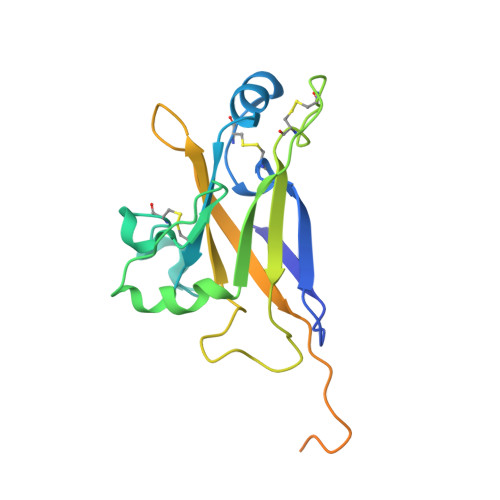Structure of the Receptor Binding Domain of EnvP(b)1, an Endogenous Retroviral Envelope Protein Expressed in Human Tissues.
McCarthy, K.R., Timpona, J.L., Jenni, S., Bloyet, L.M., Brusic, V., Johnson, W.E., Whelan, S.P.J., Robinson-McCarthy, L.R.(2020) mBio 11
- PubMed: 33203760
- DOI: https://doi.org/10.1128/mBio.02772-20
- Primary Citation of Related Structures:
6W5Y - PubMed Abstract:
EnvP(b)1 is an endogenous retroviral envelope gene found in human and other primate genomes. We report EnvP(b)1 sequences in primate genomes consistent with an integration event between 40 and 71 million years ago. Using a highly specific polyclonal antiserum raised against the putative receptor binding domain (RBD) of human EnvP(b)1, we detected expression in human placenta, ovaries, and thymus. We found that EnvP(b)1 is proteolytically processed, and using cell-cell fusion assays in multiple primate cell lines, we demonstrated that extant EnvP(b)1 proteins from a variety of primate genomes are fusogenic. This work supports the idea that EnvP(b)1 is under purifying selection and its fusogenic activity has been maintained for over 40 million years. We determined the structure of the RBD of human EnvP(b)1, which defines structural similarities with extant leukemia viruses, despite little sequence conservation. This structure highlights a common scaffold from which novel receptor binding specificities likely evolved. The evolutionary plasticity of this domain may underlie the diversity of related Envs in circulating viruses. IMPORTANCE Organisms can access genetic and functional novelty by capturing viral elements within their genomes, where they can evolve to drive new cellular or organismal processes. We demonstrate that a retroviral envelope gene, EnvP(b)1, has been maintained and its fusion activity preserved for 40 to 71 million years. It is expressed as a protein in multiple healthy human tissues. We determined the structure of its inferred receptor binding domain and compared it with the same domain in modern viruses. We found a common conserved architecture that underlies the varied receptor binding activity of divergent Env genes. The modularity and versatility of this domain may underpin the evolutionary success of this clade of fusogens.
Organizational Affiliation:
Department of Biological Chemistry and Molecular Pharmacology, Harvard Medical School, Boston, Massachusetts, USA.


















